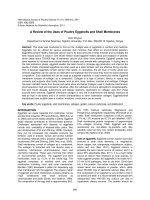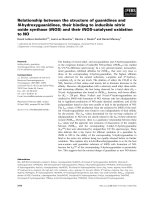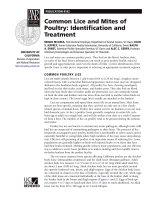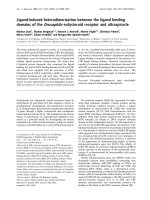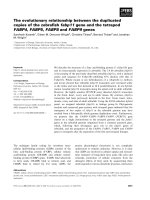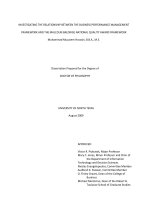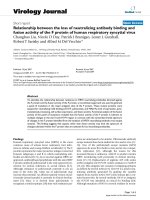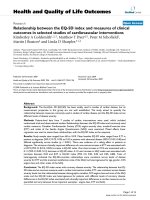Relationship between the differential managemental practices of poultry owners and their socio-personal, socio-economic and communicational characteristics in Rajouri district of Jammu and
Bạn đang xem bản rút gọn của tài liệu. Xem và tải ngay bản đầy đủ của tài liệu tại đây (273.19 KB, 11 trang )
Int.J.Curr.Microbiol.App.Sci (2018) 7(8): 4533-4543
International Journal of Current Microbiology and Applied Sciences
ISSN: 2319-7706 Volume 7 Number 08 (2018)
Journal homepage:
Original Research Article
/>
Relationship between the Differential Managemental Practices of Poultry
Owners and Their Socio-Personal, Socio-Economic and Communicational
Characteristics in Rajouri District of Jammu and Kashmir State
Mohd Saleem Choudhary1, Pranav Kumar1*, Bharat Bhushan2 and R.A. Bafanda1
1
Division of Veterinary and Animal Husbandry Extension Education, Faculty of Veterinary
Sciences and Animal Husbandry, SKUAST-J, R.S. Pura, Jammu-181102, India
2
SKUAST-J, Chatha Jammu-180009, Jammu and Kashmir, India
*Corresponding author
ABSTRACT
Keywords
Backyard poultry farms,
Managemental practices,
Organised farms,
Unorganised farms
Article Info
Accepted:
26 July 2018
Available Online:
10 August 2018
Poultry production in India has taken a quantum leap in the last four decades, emerging from an entirely
unorganized and unscientific farming practice to a commercial production system with state-of-the-art
technological interventions. Indian commercial poultry sector has advanced remarkably due to a scientific
approach adopted by the industry and an enabling environment created by the Government. The present study
was conducted in in Rajouri of Jammu and Kashmir state to assess o the managemental practices of organized
and unorganized sector of poultry production in Rajouri district of Jammu and Kashmir state. Rajouri district
consist of 19 blocks, five blocks were selected purposely having presence of good number of poultry farmers. A
compressive list of both organised and an unorganised (backyard) farm of selected blocks of Rajouri district was
prepared. From the list, 12 poultry farms each from both organised and unorganised system of poultry production
were selected randomly from five selected blocks, making a total of 120 respondents for the study. Multistage
random sampling was adopted for the research purpose. The data was collected from 120 resplendent belonging
to Nowshera Sunderban, Rajouri, Darhal and Thanamandi blocks with the help of structured interview schedule
containing selected dependent and independent variables through personal interview technique. The collected
data were analyzed by using suitable statistical tools such as frequency, percentage, mean, standard deviation;
mean percent score (MPS) technique etc. for analysis. The studies revealed that majority of respondent in
organized system were practicing semi intensive and intensive system of poultry farming, whereas, in
unorganized system all respondent were practicing extensive system of poultry production in all the five districts.
Majority of the respondents of organized system feed their birds 3 to 4 times and twice a day respectively where
as in unorganized system the birds are released in the morning and left the birds for scavenging in the
surrounding of the house. Majority of respondent feed 90 to 110 gm feed per day in organised system while in
unorganized system the birds generally fed ad-lib from scavenging. Majority per cent of respondents were
providing tap water as a source of drinking water to their birds and only 8.30 per cent respondents used from
natural sources such as spring waters (Chashme Wahae) while in backyard system of poultry rearing respondent
use open drains as a source of drinking water. In organized system of poultry rearing that majority of respondents
treat the birds by veterinary doctors while in unorganized system major 40 percent of respondents treated the
birds by self-treatment followed by paravets. In organized system major cause or mortality is due to outbreak of
diseases while majority respondents of unorganized system reported mortality due to the attack of predators.
Coccidiosis and IBD are major disease affecting production in organised while in unorganized system respiratory
problems, Fowl pox, Coccidiosis, IBD and Ranikhet diseases were reported which affects production.
Introduction
Poultry farming has been practiced in India
since the prehistoric times. The Indian red
jungle fowl is the acknowledge ancestor of
many modern day hybrid chickens. Poultry
rearing has been an integral component of
livestock production system in India. Poultry
4533
Int.J.Curr.Microbiol.App.Sci (2018) 7(8): 4533-4543
production in India has taken a quantum leap
in the last four decades, emerging from an
entirely unorganized and unscientific farming
practice to a commercial production system
with
state-of-the-art
technological
interventions. Indian commercial poultry
sector has advanced remarkably due to a
scientific approach adopted by the industry
and an enabling environment created by the
Government. The Indian Poultry Sector is
broadly divided into organized and
unorganized sub-sectors. Needs for each of the
subsectors are very different. Government of
India is catering to the needs of each of the
subsectors through development programs of
Poultry Development and for entrepreneurship
development. Central Poultry Development
Organizations are playing a pivotal role in the
coordination and dissemination of these
developmental programs of the Government.
Poultry production is highly dynamic in terms
of structural and management changes. In
today’s business environment, faster the
ability to adapt to the changing system
requirement, faster is the growth. However
sustainability often requires dependence on
other sectors like feed/ingredient inputs and
processing facilities. In India, poultry sector
growth may be attributed to many factors like
rising incomes and a rapidly expanding middle
class, together with the emergence of
vertically integrated poultry producers that
have reduced consumer prices by lowering
production and marketing costs. Integrated
production, market transition from live birds
to chilled and frozen products, and policies
that ensure supplies of competitively priced
corn and soya bean are keys to future poultry
industry growth in India. Further, disease
surveillance, monitoring and control will also
decide the fate of this sector.
Poultry sector in India has been growing at a
much faster rate than other sectors of the
Indian economy and accounts for 100 billion
rupees to the Gross National Product (GNP).
Despite such amazing growth in last two
decades, annual per capita consumption of egg
and poultry meat in India is disappointingly
low with approximately 36 eggs and 0.7
kilograms of poultry meat in 2001 (Metha et
al., 2002). These levels are too low as
compared to the world average of 147 eggs
and 10.9 kilograms of poultry meat on a per
other consumption necessities (Brahmananda
1997) capita basis (FAOSTAT). These low
levels of per capita consumption of eggs and
poultry meat have been mostly attributed to
lower purchasing power (Gandhi and Mani,
the growth rate of demand for food
commodities on the 1995). Poultry farming
has become a remunerative business and preeminence over all other livestock enterprises
in the developing countries. It carries a scope
for quick and large profit. In recent years,
backyard poultry production has been
extremely emphasised in sustaining and
enhancing rural livelihoods. In this farming,
birds are kept in low-input and low- output
system and can easily be managed by women
and children of the households. Now-a-days as
there is growing concern about meeting of per
capita requirement of protein for rural citizens
of India, poultry meat and especially eggs
have been proved to be the best and cheapest
solution to this. Concurrently, India’s
unorganised and backyard poultry sector is
also one of the potent tools for subsidiary
income generation for many landless/
marginal farmers and also provides nutritional
security to the rural poor.
Materials and Methods
The present study was carried out in Rajouri
district of J&K state. The Rajouri district was
chosen purposively because it is one among
the leading poultry production district of J&K
state. Rajouri district has more number of
organised broiler poultry farms as well as
traditional back yard poultry production
system. The district was selected purposively
4534
Int.J.Curr.Microbiol.App.Sci (2018) 7(8): 4533-4543
to have a comparative analysis of organised
and unorganized poultry production system.
Rajouri district consist of 19 blocks, five
blocks were selected proportionally having
presence of good number of poultry farmers.
A compressive list of both organised and an
unorganised (backyard) farm of selected
blocks of Rajouri district was prepared. From
the list, 12 poultry farms each from both
organised and unorganised system of poultry
production were selected randomly from five
selected blocks, making a total of 120
respondents for the study. Multistage random
sampling was adopted for the research
purpose. The data was collected from 120
resplendent
belonging
to
Nowshera
Sunderban, Rajouri, Darhal and Thanamandi
blocks with the help of structured interview
schedule containing selected dependent and
independent variables through personal
interview technique. The collected data were
analyzed by using suitable statistical tools
such as frequency, percentage, mean, standard
deviation; mean percent score (MPS)
technique etc. for analysis.
Results and Discussion
Managemental practices of
systems of poultry production
different
Managemental practices is a composite factor
involving several components, among them
knowledge regarding poultry management
practices,
attitude
towards
poultry
management practices, ability in planning,
ability to mobilize recourse, timely adoption,
efficient use of recourse and ability in rational
marketing are importance. Thus poultry
managemental practices are not a unique but a
complex process involving sequences and
thought of action. The different aspects of
poultry managemental practice in organised
and unorganised system were studied through
observation as well as through schedule. The
different aspect such as rearing, housing
management, type of housing, feeding,
healthcare, etc. were presented in table 1.
Rearing system
Table 1 reveals that majority 95% of the
respondents in organized system were
practicing semi intensive system of poultry
farming whereas only 3% were practicing
intensive systems of poultry farming. In
unorganized system all respondent were
practicing backyard system of poultry
production in all the five blocks as shown in
table 1. The findings are in agreement with the
findings of Mishra (Mishra et al., 2000) and
Ramesh (2000) reported that the broiler
farmers in Vellore district of Tamil Nadu are
adopting semi-intensive system of rearing
hybrid broiler chicken, especially during
summer. They left the birds in free range
during day time with same or more floor space
as it is inside the shed.
Night shelter
Under organized system all the respondents
were rearing broiler and they provide separate
houses. Majority of poultry owners rearing
birds in unorganized system made necessary
arrangements for night shelters of the bird to
protect them from predators. Majority (75%)
of poultry owner in unorganized system had
different shelter for night enclosure under the
same roof whereas only 8.3 per cent share the
same room with the family as shown in table
1. These findings are in agreements with the
finding of Singh and Johari (1990) who found
that the birds received housing only in the
form of night shelter.
Litter material provided
The present study reveals that in organized
system all the respondent provided litter
material whereas none of the respondents in
unorganized system of poultry production
4535
Int.J.Curr.Microbiol.App.Sci (2018) 7(8): 4533-4543
provided litter material but they were
providing torn and used gunny bags 65 per
cent and rest 35 per cent used combination of
straw and dry leaves as the bedding material.
In case of organized system of poultry
production different types of litter material
were used. Among them 83.3% use saw dust
and 16.7% rice husk as the as the litter
material as shown in table 1. The findings are
in agreement with the findings of Mathialagan
and Subramanian (1995).
Housing system in organised
unorganised poultry farms
reveal that the majority (87.7%) respondents
in organized system had the poultry house1 to
2 feet and rests 12.3 percent have 2 to 3 feet
from the ground level whereas in unorganized
system poultry houses were made at different
height from the ground level. Similar findings
were
reported
by
Mathialagan
and
Subramanian (1995) and Singh and Johri
(1990).
Different arrangement made for chicks and
birds practices in organised farms
and
Arrangement made for chicks and birds
Maintaining the in house temperatures is very
important for sustaining the productivity from
the birds. Suitable poultry housing is very
important for successful poultry farming
business. Poultry birds can be raised in both
free range and indoor production systems. In
case indoor production system, it is very
crucial to manage the environment. But for
sustainable commercial poultry production,
planned and proper designed poultry housing
is very essential to keep the poultry birds
healthy and productive. And this will increase
the farming production and income.
A perusal of table 2 reveals that majority of
poultry owners in unorganized system (70%)
kept the birds in kacha house prepared by
locally available material like mud broken
bricks, tiles, and wire net where as 21.67%
and 8.33% respondents kept their birds in
wooden and chapper house respectively. All
the respondents of organized system were
providing upto 0.5 square feet space per chick
and 0.8-12 square feet space in case of broiler
birds. In unorganized system, the birds receive
housing only in the form of night shelter and
they are allowed to scavenge by themselves in
the surrounding during the day time. The
space provided by the poultry owners
according to the flock size and some time
houses were made in different tier. Table 2
On perusal of table 3 it was found that all
poultry farmers in the organized system had
electricity connection in their poultry farms.
For brooding purpose all the respondents had
electric hover and bukhari (locally made
heating system based on coal/wood). About 95
percent poultry farmers had made optimum
temperature for their chicks and birds. All the
poultry farms had chick guard. About 75 per
cent poultry farmers had optimum and
adequate equipments at their poultry farms.
Majority 80 per cent farms were located at less
crowded place whereas 90.4 per cent farms
were well connected to the road. Table 3
shows that in organized system majority
(80.2%) respondents gave 6 hr artificial light
and 19.8% respondents provide more than 6
hrs of artificial light. The findings are in
agreement with the findings of Mathialagan
and Subramanian (1995) who reported that
lighting (98.67%) was provided by the most of
the farmers in Namakkal district in Tamil
Nadu. As per arrangement at required interval
is concerned table 3 shows that all the
respondents in the organized system changed
litter, clean and disinfect the equipments at the
certain interval. All respondents done room
disinfection and white wash after some time
interval respectively. The findings are in
agreement with the findings of Mathialagan
4536
Int.J.Curr.Microbiol.App.Sci (2018) 7(8): 4533-4543
[4] who reported that the economic ability of
poultry units mainly depends on scientific
management. The practices like disinfection
(98.67%), water space (96%), lighting
(98.67%),
litter
management
(100%),
Vaccination (100%). Coccidiost (100%),
debeaking (100%) and deworming (80%),
were adopted by almost all respondents,
whereas, the housing (85.33%), floor space
(70.67%), sanitation (65.33%) and culling
(67%) were not adopted by the most of the
farmers in Namakkal district in Tamil Nadu.
Table.1 Different managemental practices of different systems of poultry production
Managemental practices
Rearing system
Extensive
Intensive
Semi intensive
Night shelters
Separate house
Shared own house
Any other
Litter materials /bedding materials
Saw dust
Groundnut shells
Paddy husk
Rice husk
Gunny bags
Straw +dry leaves
Organized (n=60)
Unorganized (n=60)
0(0)
3(5)
57(95)
60 (100)
0(0)
0(0)
60 (100)
0(0)
0(0)
0(0)
5(8.33)
45(75)
50(83.3)
0(0)
0(0)
10(16.7)
0(0)
0
0
0(0)
16.7
0(0)
(65)
(35)
Table.2 Housing system in organised and unorganised poultry farms
Housing managemental practices
Type of poultry farm
1. Type of house
Kacha house
Wooden house
Chapper house
Space provided per bird
Chicks
Broiler
Height from ground level
1 - 2 feet
2-3 feet
Unorganised (n=60)
70
21.67
8.33
Organised (n=60)
0.5 square feet
0.8-12 square feet
Organised (n=60)
87.7
12.3
4537
Int.J.Curr.Microbiol.App.Sci (2018) 7(8): 4533-4543
Table.3 Different arrangement made for chicks and birds practices in organised farms
Variable
Arrangement made for chicks and birds
Electricity supply
Chick guard
Hover (Electric)+ Bukhari
Optimum and adequate equipments
Optimum temperature
Road connection
Less crowded place
Artificial light provided to birds
6 hrs
More than 6 hrs
Arrangement at required interval
Litter changed
Poultry house disinfected
Cleaning and disinfection of poultry equipment
White wash inside poultry house
Organised (n=60)
60(100
60(100)
60(100)
45(75)
57(95)
54.24(90.4)
48(80)
48.12(80.2)
11.88(19.8)
60(100)
60(100)
60(100)
60(100)
Table.4 Classification of the respondents according to feeding and watering material used
Material
Organised (n=60)
Feeder
Plastic
Metallic
Earthen pots
Waterer
Plastic
Metallic
Earthen pots
60(100)
0(00)
0(00)
60(100)
0(00)
0(00)
Table.5 Feeding system of organised and unorganised farms
Feeding management
Frequency of feeding
Once
Twice
3-4 time
Total
Quantity of feed (grams)
70 to 90
90 to 110
110 to 130
ad-lib
Organised (n=60)
Un-Organised (n=60)
0(100)
34(56.67)
26(43.33)
100
60(100)
0(100)
0(100)
100
9(15)
36(60)
15(25)
(00)
(00)
(00)
(00)
60(100)
4538
Int.J.Curr.Microbiol.App.Sci (2018) 7(8): 4533-4543
Table.6 Classification of the respondents according to time of feeding
Time of feeding
Morning
Afternoon
Evening
Night
Total
Unorganized (n=60)
3 (5)
11(18)
46(76)
0(0)
60(100)
Table.7 Classification of the respondents according to Sources of drinking water used in farms
Sources of drinking water
Natural source
Tap water
Stagnant water
Open drain
Frequency of watering
Twice
3-4 time
Total
Organized (n=60)
5(8.3)
55(91.7)
0(0)
0(0)
Organised (n=60)
26(43.33)
34(56.67)
100
Table.8 Health management practices of different systems of poultry production
Health management
Treatment of birds
veterinary doctors
Paravets
local experts/ Hakeem
Self treatment
No treatment
Medicine used
Allopathic medicine
Ayurvedic medicine
Homeopathy
Home made
No medicine
Type of vaccination
Newcastle disease
Marek’s disease
Infectious Bursal disease
Source of vaccine
Local input dealers
From market
Govt. Supply
Organized (n=60)
Unorganized (n=60)
40.02(66.77)
12.6(21)
6.6(11)
0
0
1.8(3)
16.2(27)
9(15)
24(40)
4.2(7)
60(100)
0(0)
0(0)
0(0)
0(0)
33(55)
1.8(3)
1.2(2)
19.8(33)
4.2(7)
60(100)
60(100)
60(100)
0(00)
0(00)
0(00)
48(80)
9(15)
3(5)
0(00)
0(00)
0(00)
4539
Int.J.Curr.Microbiol.App.Sci (2018) 7(8): 4533-4543
Table.9 Mortality of birds in different systems of poultry production
Diseases
Cause of mortality of birds
Disease
Chilling
Attack of predators
Disease encountered
Respiratory disease
IBD
Coccidiosis
Fowl pox
Ranikhet
Organized (n=60)
Unorganized (n=60)
57(95)
3(5)
0(00)
1.8(3)
0(00)
58.2(97)
18(30)
48(80)
48(80)
0(00)
7.2(12)
13.8(23)
10.2(17)
6(20)
7.2(12)
7.2(12)
Feeding and watering management of
organised and unorganised farms
Feeding and watering material
On perusal of table 4 it was found that all the
organized poultry farmer were using plastic
feederers and waterer whereas none of the
farms were using either metallic or earthen
pots for feeding and watering purposes.
On the other hand in unorganized system
water was provided in unused utensils/bowl
/earthen pots kept in courtyard or birds were
allot to drink water from open drains while
for feeding purpose no utensil were used,
grains were thrown in the courtyard for the
birds to pick up. Similar findings were
reported by Mathialagan and Subramanian
(1995) and Singh and Johri (1995).
Feeding system
unorganised farms
of
organised
and
Nutrition management allows improvement to
feed conversion ratios through optimal diet
balancing and feeding regimes, and
improvement to feed digestibility. An
important part of raising chickens is feeding feeding makes up the major cost of
production and good nutrition is reflected in
the bird's performance and its products.
Success on poultry production rests primarily
on the quality of the bird employed,
comforting environment and provision for
good feed, the last being most expensive of all
other inputs, deserves befitting attention.
In backyard poultry rearing, the practice
prevalent in the rural area was of leaving the
bird for scavenging in the morning and also
giving hand full of grains. The feeding
practice was very causal. The birds generally
scavenged on locally available birds and
seeds but in organized system of poultry
rearing the birds are provided with regular
feeds in their house.
Table 5 shows that a mixed type frequency of
feeding pattern was observed in organized
system of the study area Majority of the
respondents (56.67%) fed twice and rest
43.33% of respondents feed their birds 3 to 4
times depending on the requirements.
Where as in unorganized system the birds are
released in the morning and left the birds for
scavenging in the surrounding of the house,
gardens, field etc. from where they fulfill their
requirement of feed. From table 5 it was
found that majority (60%) of respondent feed
90 to 110 gm feed per day whereas (25%) and
4540
Int.J.Curr.Microbiol.App.Sci (2018) 7(8): 4533-4543
(15%) respondent fed 110 to 130 gm and 70
to 90 gm respectively. In unorganized system
the birds generally fed ad-lib from
scavenging. Similar findings were also
reported by Dana et al., (1999), Reddy and
Reddy (2000) and Scencic (2004). Singh
(1988) reported that the backyard chicks that
survive mainly by scavenging are an
important resource for upliftment of rural
landless people in India.
Time of feeding
Table 6 shows that majority (76%) of
respondents in unorganized system poultry
farmers offer supplementary feeds in the
evening followed by (11%) and (3%)
respondents offer in the afternoon and
morning respectively. these findings were in
agreement with the findings of Dana et al.,
(1999), who conducted a study on animal
husbandry practices among santal tribes
district of West Bengal and reported that
64.98% respondents offer any feeding in
addition in the evening, whereas 25.09%
respondents feeds in the afternoon.
Source of drinking water
A perusal of Table 7 reveals that 91.7 per cent
respondents of organized system used water
from tap water and only 8.30 per cent
respondents used from natural sources such as
spring waters (Chashme Wahae).
All the respondents provide water to birds but
its frequency varied from season to season.
During summer majority of respondents
43.33% offers water to birds 3 to 4 times per
day while in winter it was providing only 1 to
2 times per day.
Similar findings have been reported by Dana
et al., (1999), Mathialagan and Subramanian
(1995), Reddy and Reddy (2000) and Saha
(2003).
Health management
Health management practices of different
systems of poultry production
Management of diseases in poultry plays an
important role for the progress of the industry.
Birds in the commercial farms are reared in
open sided houses and maintained under
optimum management conditions. Birds are
reared
under
veterinary
supervision.
Vaccination is regularly practiced to protect
the bird against diseases. Table 8 shows that
majority 66.77 per cent of respondents treat
the birds by veterinary doctors. About 21
percent treated the birds by paravets local and
11 percent respondents treated the birds by
local experts/Hakeem. In unorganized system
major 40 percent of respondents treated the
birds by self-treatment followed by paravets
(27%), local experts/ Hakeem (15%) and
veterinary doctor (3%). About 7 per cent
respondents in unorganized system did not
treat their birds. These findings were also in
accordance with the findings of Ramgopal et
al., (2001) but in contrast with the findings of
Oladduni and Fatuase (2014). Oladduni and
Fatuase conducted a study on economic
analysis of backyard poultry farming in
Akoko North West Local Government Area
of Ondo State, Nigeria and found that
majority of the respondent (84.2%) treated
their sick birds by themselves while only
15.8% of them consulted veterinary doctor.
This is an indication that the health care to the
respondents was not significant. All the
respondent of the organized system used
allopathic medicine for the treatment. In
unorganized system 55 per cent of
respondents used allopathic medicine for the
treatment of birds while 33 percent used
homemade medicines, rest 3 percent
ayurvedic
medicine
and
2
percent
homeopathy table 8. Around 7 percent don’t
use any medicine. All the respondent of
organized system vaccinated their birds
4541
Int.J.Curr.Microbiol.App.Sci (2018) 7(8): 4533-4543
whereas none of the respondents in
unorganized system did any vaccination of
their birds. Table 8 also shows that all the
respondents of organized system vaccinated
their birds against Newcastle disease, Marek’s
disease and Infectious Bursal disease.
Majority of respondents (80%) purchase the
vaccine input from the local dealers whereas
(15%) and (5%) of the respondents got the
vaccine from the market and govt. supply
respectively (Table 8). The findings are in
agreement with the findings of Mathialagan
and Subramanian (1995), and Reddy and
Reddy (2000) who reported that majority
respondents of organized system vaccinated
their birds. Mandal and Gautam (2003) in
their study found that backyard poultry
farming was an important practice among the
poor and landless agriculture labourers in R.S
Pura Tehsils of Jammu district and reported
that vaccination of the birds was not practiced
in any of the villages studied.
reported Respiratory diseases in their farms.
In unorganized system around 23 percent
respiratory problems, 12 percent Fowl pox, 20
percent Coccidiosis, 17 percent IBD and 12
percent Ranikhet diseases were reported. The
results of present study are in agreement with
the results reported by Sharma Sharma et al.,
(2003). Who conducted a study on poultry
coccidiosis in organized and backyard farms
of Jammu region and found that higher
prevalence of 53.61% in unorganized
(backyard poultry birds) as compared to
organized birds (25.55%) was recorded. The
prevalence was the highest in monsoon from
both organized and unorganized manage
mental practice. Also reported that poultry
diseases like Coccidiosis, Salmonellosis,
Ranikhet disease, chronic respiratory diseases
and fowl pox were the major cause of
mortality of birds. Lack of knowledge about
the diseases was the main reason for this
problem.
Mortality of birds
Based on finding of result it can be concluded
that In J&K organized poultry managemental
practices is fairly developed and continues to
develop rapidly but the study showed that
there was lack of awareness about newer
methods of poultry managemental practices.
There is an urgent need of regular training of
poultry farmers about the latest method of
poultry rearing practices. Much less attention
has been given to the development of
unorganized poultry systems. In order to
improve the nutritional and economic security
of the people living in rural and inaccessible
areas in a sustained manner, the promotion of
back yard poultry is appropriate and actively
practiced. Much more efforts are required to
provide unorganized poultry farmers with
latest information on the benefits of
maintaining poultry in good health and
productive states by supplementary feeding
and vaccination. The provision of information
can be done through community based,
animal health care workers, NGOs and
A perusal of table 9 shows 95 per cent of the
respondents under organized system reported
mortality due to outbreak of diseases and 5per
cent respondents reported mortality due to
chilling, huddling etc. Majority 97 percent
respondents of unorganized system and 3per
cent respondent of organized system reported
mortality due to the attack of predators and
outbreak of disease respectively. Similar
findings
were
also
reported
by
Prawirokusumo (1988) and Sharma et al.,
(2003). Prawirokusumo stated that the cause
of high mortality in native chicken is probably
due to lack of protection against Newcastle
disease disaster and feed inadequacies during
early stage of life (during the first 6 weeks of
age).
Table 9 reveals that majority of respondents
of the organized system (80%) each reported
that Coccidiosis and IBD. About 30%
4542
Int.J.Curr.Microbiol.App.Sci (2018) 7(8): 4533-4543
government organizations. Activities such as
organized health management programs, with
basic
training
covering
vaccination,
deworming and treatment or prevention of
major diseases, should be developed further
and implemented. Advice should be provided
on good management procedures such as
providing protective shelters/ housing for the
birds to reduce predators’ problems.
Supplementary feeding should be encouraged
to rectify malnutrition problems due to
shortage of feeds.
References
Brahmananda PR. 1997. 2020 vision for Indian poultry
industry. International journal of poultry
science. 6:139-143
Dana SS, Khandekar N and Sharma RP. 1999. Training
need of farmers about commercial poultry
production. Indian Journal of Animal Health.
38(1): 45-46.
Mandal MK and Gautam. 2003. Status of backyard
poultry farming in R.S. Pura Tehsil of Jammu
district. Journal of Interacademica. 7(4): 491493.
Mathialagan P and Subramanian R. 1995. Extend of
adoption of improved poultry practices. Journal
of Extension Education. 6(2): 1130-1133.
Metha R, Nambiar RG, Singh SK, Subrahmanyanm S
and Ravi C. 2002. Livestock industrialization,
trend and social health environmental issues for
the Indian poultry sector. Annex II, Part of
IFPRI-FAO livestock industrialization project.
Mishra SP, Mohapatra BP, Dehuri PK, Mishra PK. A
study on the present status of poultry farming in
Orissa. Paper presented in XX Annual
Conference and Symposium of Indian poultry
science Association, “Challenge to Poultry
industry in the new millennium”, 12-14th
October, 2000, Chennai: 303-307.
Oladunni ME and Fatuase AI. 2014. Economic
Analysis of Backyard Poultry Farming in Akoko
North West Local Government Area of Ondo
State, Nigeria. Global Journal of Biology,
Agriculture and Health Sciences. 3(1): 141-147.
Pra`wirokusumo S. 1988. Problems to improve small
scale native chickens management in south-east
Asian countries. Proceedings XVIII World’s
Poultry Congress, Nagoya, Japan.113-117.
Ram Gopal, Sachdev AK and Rajvir Singh. 2001.
Study on distribution and expectation of Indian
poultry industry. Indian journal of Poultry
Science. 36(3):280-283
Ramesh J. 2000. Semi-Intensive system of hybrid
broiler rearing. Paper presented in XX Annual
Conference and Symposium of Indian poultry
science Association, “Challenge to Poultry
industry in the new millennium”, 12-14th
October, Chennai.14-19.
Reddy GR and Reddy SJ. 2000. Extent of adoption of
poultry technology by diversified farmers in
Guntur District of Andhra Pradesh. Journal of
Research-ANGRAU. 28(1/2): 42-50.
Saha, D. 2003. Status of rural poultry production in
North 24 Paraganas district of West Bengal.
M.V.Sc. Thesis, Division of Extension
Education, IVRI, Izatnagar
Scencic, Antunovic Z and Speranda M. 2004.
Ecological importance of litter in poultry
production. Stocarstvo. 58(1): 71-78.
Sharma S, Iqbal A, Azmi S and Shah HA. 2013. Study
of poultry coccidiosis in organized and backyard
farms of Jammu region. Vet World. 6(8): 467469.
Singh DP and Johari DC. 1990. Kadaknath the native
fowl needs to be conserved, Indian Farming.
26:19-32
Singh H. 1988. Marketing of poultry birds. Indian
Journal of Animal Production and Management.
4 (3&4): 133-138.
How to cite this article:
Mohd Saleem Choudhary, Pranav Kumar, Bharat Bhushan and Bafanda, R.A. 2018.
Relationship between the Differential Managemental Practices of Poultry Owners and Their
Socio-Personal, Socio-Economic and Communicational Characteristics in Rajouri District of
Jammu and Kashmir State. Int.J.Curr.Microbiol.App.Sci. 7(08): 4533-4543.
doi: />
4543
